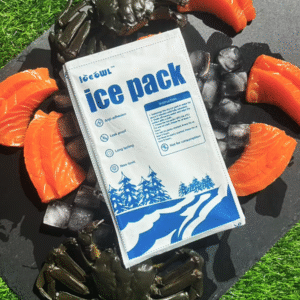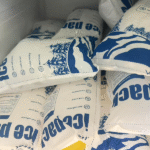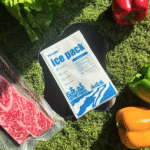Comment les packs de glace sèche de Medical Supply garantissent une expédition sûre et efficace dans la chaîne du froid
Dans les industries pharmaceutique et médicale, garantir que les produits sensibles à la température, tels que les vaccins, biologique, et les échantillons de sang conservent leur efficacité pendant le transport est primordial. Packs de glace carbonique pour fournitures médicales jouer un rôle crucial dans la réalisation de cet objectif en fournissant les températures inférieures à zéro nécessaires pour maintenir la stabilité de ces produits. Glace sèche, sublimant à une température de -78,5°C (-109.3°F), offre la méthode de refroidissement la plus fiable, en particulier pour les produits qui nécessitent des conditions congelées. Ce guide explorera les avantages de l'utilisation de blocs de glace carbonique, Comment ils fonctionnent, et comment sélectionner la meilleure solution pour vos envois médicaux.
-
Que sont les packs de glace carbonique pour fournitures médicales, et comment fonctionnent-ils dans la logistique de la chaîne du froid?
-
Comment les packs de glace sèche destinés aux fournitures médicales maintiennent-ils la stabilité de la température pendant le transport?
-
Quels sont les principaux avantages de l'utilisation de la neige carbonique pour l'expédition de fournitures médicales?
-
Comment pouvez-vous sélectionner les meilleurs packs de glace carbonique pour fournitures médicales pour vos envois?
Que sont les packs de glace carbonique pour fournitures médicales, Et comment fonctionnent-ils?
Les packs de glace carbonique pour fournitures médicales sont des blocs ou des feuilles solides de dioxyde de carbone (Co₂) qui assurent le refroidissement à des températures extrêmement basses. Ces packs sont uniques car ils sublimer directement du solide au gaz, absorbant la chaleur de leur environnement et créant un environnement froid essentiel à la stabilité des vaccins, échantillons de sang, et autres produits biologiques. Contrairement à la glace traditionnelle, qui fond dans l'eau, la glace carbonique ne laisse aucun résidu, ce qui en fait une option plus propre et plus efficace pour les envois médicaux.
Ce processus de sublimation garantit que packs de glace sec peut maintenir des températures aussi basses que -78,5°C (-109.3°F), une gamme parfaite pour les produits les plus sensibles. Lorsqu'il est emballé dans des conteneurs isothermes, ces blocs de glace carbonique peuvent maintenir un refroidissement constant pendant de longues périodes de transport.
Comment les packs de glace carbonique d'approvisionnement médical maintiennent-ils la stabilité de la température?
Les blocs de glace carbonique maintiennent la stabilité de la température pendant le transport en absorbant la chaleur de leur environnement lors de leur transition du solide au gaz. (sublimation). Ce processus abaisse la température à l’intérieur du conteneur d’expédition, maintenir les produits médicaux aux basses températures requises.
Le facteur clé est le point de sublimation de glace carbonique- ce qui est bien inférieur aux solutions réfrigérées ou congelées typiques. La glace carbonique se sublime à -78,5°C (-109.3°F), ce qui est essentiel pour conserver les produits biologiques et les vaccins qui nécessitent un stockage ultra-froid. Ce contrôle étendu de la température garantit que les produits médicaux restent viables pendant de plus longues périodes, ce qui est particulièrement important pour les expéditions longue distance ou internationales.
Principaux avantages de l'utilisation de packs de glace carbonique pour fournitures médicales
Lors du transport de fournitures médicales, les packs de glace carbonique offrent de nombreux avantages:
-
Durée de refroidissement prolongée: La glace sèche maintient des températures extrêmement basses pendant 24-48 heures, parfois plus long selon la taille et l'emballage, ce qui est idéal pour les expéditions nécessitant un refroidissement à long terme.
-
Non toxique et sans danger pour le transport: Contrairement à d'autres matières dangereuses comme l'azote liquide, la glace sèche n'est pas toxique, ce qui le rend plus sûr à manipuler lorsque les précautions appropriées sont prises. C'est aussi une option plus sûre que la glace, ce qui peut créer de l'humidité et compromettre l'intégrité des fournitures médicales.
-
Utilisation efficace de l'espace: Les packs de glace carbonique sont compact et peut être facilement intégré dans des conteneurs maritimes, optimiser l'espace disponible pour le transport des produits médicaux.
| Avantage | Packs de glace sec | Packs de gel | Packs de glace |
|---|---|---|---|
| Contrôle de la température | Maintient les conditions de gel | Convient pour le refroidissement à court terme | Efficace pour le refroidissement à court terme |
| Durée de refroidissement | 24-48 heures | 6-12 heures | Varie |
| Rentabilité | Efficacité de refroidissement élevée | Moins efficace | Moins efficace pour les expéditions longues |
| Adéabilité pour les biens sensibles | Idéal pour les vaccins, sang, biologique | Idéal pour les articles non critiques | Convient aux produits moins délicats |
Comment choisir les bons packs de glace carbonique pour fournitures médicales
Choisir le bon packs de glace carbonique pour fournitures médicales dépend de vos besoins d'expédition spécifiques:
-
Exigences de température du produit: Comprendre la plage de température dont vos produits médicaux ont besoin. Certains produits, comme certains vaccins, nécessitent une surgélation, tandis que d'autres peuvent n'avoir besoin que de réfrigération.
-
Durée de l'expédition: Si vous expédiez pour une période prolongée, il est crucial de considérer des packs de glace carbonique plus grands ou supplémentaires pour garantir que la température requise est maintenue tout au long de l'expédition.
-
Conditions environnementales: Gardez à l'esprit que facteurs externes comme la température et l'humidité peut influencer le taux de sublimation de la neige carbonique. Par exemple, dans des environnements plus chauds, vous aurez peut-être besoin de plus de neige carbonique ou d'une isolation améliorée pour maintenir la stabilité.
Applications réelles des packs de glace carbonique pour fournitures médicales
Les packs de glace sèche pour fournitures médicales sont couramment utilisés dans diverses applications du monde réel pour garantir que les produits médicaux restent dans la plage de température requise pendant le transport.:
-
Scénario 1: Expédition de vaccins à travers les pays: Une entreprise pharmaceutique doit expédier un lot de vaccins. Packs de glace sec sont utilisés pour conserver les vaccins à la température de congélation requise, s'assurer qu'ils arrivent en toute sécurité et restent efficaces.
-
Scénario 2: Transport d'échantillons de sang pour la recherche: Un hôpital doit envoyer des échantillons de sang pour analyse. Des packs de glace carbonique sont utilisés pour conserver les échantillons congelés, prévenir la dégradation ou la perte de viabilité.
Considérations clés lors de l’utilisation de packs de glace carbonique pour fournitures médicales
Bien que la glace carbonique soit très efficace, il y a des considérations importantes:
-
Mesures de sécurité: Gérer toujours la glace sèche avec soin, porter des gants isolés pour éviter les engelures. Assurer la bonne ventilation pour éviter l'accumulation de CO₂.
-
Emballage approprié: Veiller à ce que les fournitures médicales soient emballé en toute sécurité pour éviter tout dommage et que la neige carbonique soit emballée de manière à maintenir son efficacité tout au long du voyage.
-
Règlements: La neige carbonique est classée comme matière dangereuse et doit être correctement étiqueté selon Règlements DOT une fois expédié.
2025 Tendances et développements dans le transport de fournitures médicales
À mesure que nous approchons 2025, plusieurs tendances façonnent l’avenir de expédition de fournitures médicales et logistique de la chaîne du froid:
-
Durabilité dans la production de glace carbonique: Il y a une demande croissante pour glace sèche écologique solutions. Les entreprises explorent des méthodes pour capter le CO₂ provenant des processus industriels et l’utiliser pour créer de la neige carbonique négative en carbone..
-
Surveillance de la température compatible IoT: L'utilisation de Technologie IoT pour la surveillance en temps réel des conditions de température améliore la transparence et la conformité des expéditions médicales.
-
Logistique optimisée par l'IA: Intelligence artificielle améliore la planification des itinéraires et l'allocation de glace carbonique, garantir l’utilisation la plus efficace des ressources et minimiser les retards.
Aperçu des derniers développements
-
Glace sèche à carbone négatif: L'utilisation du CO₂ issu des émissions capturées contribue à réduire l'empreinte carbone de la production de glace carbonique.
-
Emballage intelligent: Intégration de capteurs de température et Codes QR permet une surveillance en temps réel et une plus grande visibilité.
-
Focus sur la durabilité: Un pas vers biomousse et d'autres Matériel d'emballage durable rend l’industrie de la chaîne du froid plus respectueuse de l’environnement.
Questions fréquemment posées
Q1: Combien de temps durent les packs de glace carbonique pour fournitures médicales pendant l'expédition?
Les packs de glace carbonique durent 24 à 48 heures, en fonction de la taille du paquet, isolation, et conditions extérieures.
Q2: La glace carbonique peut-elle être utilisée pour expédier des échantillons biologiques?
Oui, la glace carbonique est couramment utilisée pour expédier des échantillons biologiques tels que sang et tissus, car il maintient les conditions de congélation nécessaires.
Conclusion et recommandations
En conclusion, packs de glace carbonique pour fournitures médicales sont indispensables à la logistique de la chaîne du froid. Ils offrent refroidissement fiable qui garantit l'intégrité des produits sensibles comme les vaccins et les produits biologiques pendant le transport. En utilisant de la neige carbonique, les entreprises peuvent minimiser la détérioration, réduire les coûts, et améliorer l'efficacité de leurs opérations d'expédition.
Étapes suivantes: Comment mettre en œuvre des packs de glace carbonique pour vos expéditions de fournitures médicales
Pour mettre en œuvre efficacement des packs de glace carbonique:
-
Évaluez vos produits’ Exigences de température et choisissez la bonne solution de glace carbonique.
-
Formez votre personnel sur la manipulation sécuritaire de la neige carbonique et s’assurer qu’ils comprennent la conformité réglementaire.
-
Assurer un emballage approprié pour protéger à la fois la neige carbonique et les fournitures médicales pendant le transport.
Pour des conseils supplémentaires, veuillez nous contacter pour obtenir des conseils d'experts adaptés à vos besoins spécifiques.
























